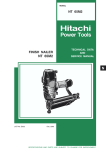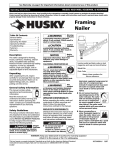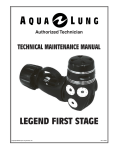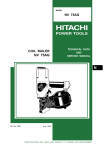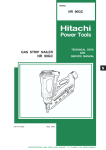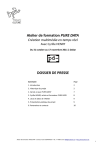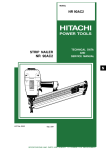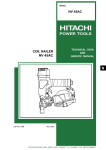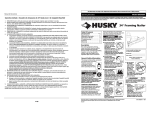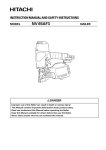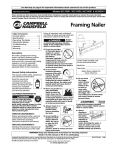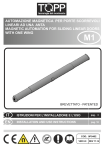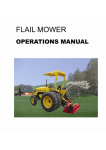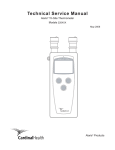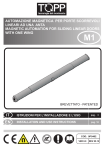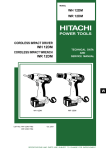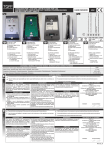Download Hitachi
Transcript
MODEL NR 90AD Hitachi Power Tools STRIP NAILER NR 90AD TECHNICAL DATA AND SERVICE MANUAL N LIST No. E016 Jun. 2004 SPECIFICATIONS AND PARTS ARE SUBJECT TO CHANGE FOR IMPROVEMENT REMARK: Throughout this TECHNICAL DATA AND SERVICE MANUAL, a symbol(s) is(are) used in the place of company name(s) and model name(s) of our competitor(s). The symbol(s) utilized here is(are) as follows: Competitors Symbols Utilized Company Name Model Name P Paslode F-350S Q SENCO FramePro 701XP CONTENTS Page 1. PRODUCT NAME ............................................................................................................................. 1 2. MARKETING OBJECTIVE ............................................................................................................... 1 3. APPLICATIONS ................................................................................................................................ 1 4. SELLING POINTS ............................................................................................................................ 1 5. SPECIFICATIONS ............................................................................................................................ 2 5-1. Specifications ..................................................................................................................................... 2 5-2. Explanation of the Nailing Action ....................................................................................................... 3 5-3. Nail Selection ..................................................................................................................................... 4 5-4. Nail Driving Force .............................................................................................................................. 5 6. COMPARISONS WITH SIMILAR PRODUCTS ................................................................................ 6 7. PRECAUTIONS IN SALES PROMOTION ....................................................................................... 7 7-1. Handling Instructions ......................................................................................................................... 7 7-2. Warning Label .................................................................................................................................... 7 7-3. Related Laws and Regulations .......................................................................................................... 8 8. MECHANISM AND OPERATION PRINCIPLE ................................................................................. 9 8-1. Mechanism ........................................................................................................................................ 9 8-2. Operation Principle .......................................................................................................................... 11 9. TROUBLESHOOTING GUIDE ....................................................................................................... 14 9-1. Troubleshooting and Correction ....................................................................................................... 14 9-2. Regrinding the Driver Blade ............................................................................................................. 17 9-3. Possible Causes and Correction of Air Leakage ............................................................................. 18 10. DISASSEMBLY AND REASSEMBLY .......................................................................................... 20 10-1. General Precautions in Disassembly and Reassembly ................................................................. 20 10-2. Disassembly and Reassembly of the Output Section .................................................................... 21 10-3. Disassembly and Reassembly of the Control Valve Section ......................................................... 24 10-4. Disassembly and Reassembly of the Driving Section ................................................................... 27 10-5. Disassembly and Reassembly of the Cap and the Magazine Section .......................................... 30 11. INSPECTION AND CONFIRMATION AFTER REASSEMBLY .................................................... 33 12. STANDARD REPAIR TIME (UNIT) SCHEDULES ....................................................................... 34 Assembly Diagram for NR 90AD 1. PRODUCT NAME Hitachi 90 mm (3-1/2") Strip Nailer, Model NR 90AD 2. MARKETING OBJECTIVE The Model NR 90AD is a framing nailer for clipped head (D-head) nails. This is developed as a next-generation nailer with an all-new design in order to expand our market share. The main features of the Model NR 90AD are as follows: (1) Lightweight (3.2 kg) and good balance (2) Low height (3) Rapid driving and quick response mechanism (4) New aggressive appearance (5) Selective actuation (single actuation/contact actuation) (6) Tool-less depth adjustment (7) Comfortable grip 3. APPLICATIONS Floor and framing Truss build-up, window build-up Subflooring and roof decking Wall sheathing Mobile home and modular housing construction 4. SELLING POINTS Lightweight, only 3.2 kg (7.0 lbs.) and good balance New aggressive appearance Comfortable grip Low height With "single actuation/ contact actuation" selector Rapid driving and quick response Tool-less depth adjustment --- 1 --- 5. SPECIFICATIONS 5-1. Specifications NR 90AD Model Driving system Reciprocating piston type Operating pressure 5 --- 8.5 kgf/cm2 (70 --- 120 psi, 4.9 --- 8.3 bar) (Gauge pressure) Driving speed 3 pcs./sec. Weight 3.2 kg (7.0 lbs.) Dimensions (Length x Height x Width) 462 mm x 322 mm x 125 mm (18-3/16" x 12-11/16" x 4-15/16") Nail feed system Spiral spring Nail capacity 86 nails Air consumption 2.5 ltr/cycle at 7 kgf/cm2 (0.088 ft3/cycle at 100 psi) (2.5 ltr/cycle at 6.9 bar) Air inlet 3/8 NPT thread Packaging Corrugated cardboard box Package dimensions (Length x Height x Width) 587 mm x 398 mm x 136 mm (23-1/8" x 15-21/32" x 5-11/32") Standard accessories Optional accessories Safety glasses (Code No. 875769) ............................................................ 1 Pneumatic tool lubricant (1 oz oil feeder) (Code No. 877153) Pneumatic tool lubricant (4 oz oil feeder) (Code No. 874042) Pneumatic tool lubricant (1 quart can) (Code No. 876212) Grease (ATTOLUB No. 2) (500 g (1.1 lbs.)) (Code No. 317918) --- 2 --- 5-2. Explanation of the Nailing Action To meet the requirements of "ANSI SNT-101-2002", the Model NR 90AD is equipped with a nailing operation switching device at the valve portion as shown in the figures below. Use SINGLE ACTUATION MECHANISM (SINGLE SEQUENTIAL ACTUATION MECHANISM) or CONTACT ACTUATION MECHANISM in accordance with the work to be performed. Each nailing operation is as follows. SINGLE ACTUATION MECHANISM (SINGLE SEQUENTIAL ACTUATION MECHANISM): First, press the pushing lever against the wood; next, pull the trigger to drive the nail. First, pull the trigger; next, press the pushing lever against the wood to drive the nail. After nailing once, nailing will not be possible again until the trigger is released and pressed again. CONTACT ACTUATION MECHANISM: First, press the pushing lever against the wood; next, pull the trigger to drive the nail. First, pull the trigger; next, press the pushing lever against the wood to drive the nail. If the trigger is held back, a nail will be driven each time the pushing lever is pressed against the wood. Nailing operation switching device Switching device (Change knob) Switching device (Change knob) SINGLE ACTUATION MECHANISM (Switching device: upward position) CONTACT ACTUATION MECHANISM (Switching device: downward position) --- 3 --- 5-3. Nail Selection The Model NR 90AD utilizes D-head (clipped head) nails collated with paper tape. Applicable nail dimensions are shown below. Please note that screw-type nails cannot be used with the Model NR 90AD. Ensure that nails are as specified in Fig. 1. The Model NR 90AD utilizes D-head (clipped head) nails collated at an angle of 35 degrees which are the same as the nails utilized by P. However, some D-head nails made by other makers are collated at a different angle of 26 degrees. Use of such nails will cause clogging of nails and subsequent damage to the nailer. Also avoid use of misaligned nails or nails collated with a weak paper tape. Do not use P's 2" Roundrive nail (eccentric full round head nail) with the Model NR 90AD because it may cause bending of nails. It is recommended to use genuine HITACHI nails to ensure satisfactory driving quality. Paper tape collated strip nails D-head (clipped head) nails Minimum Maximum 7.7 mm (0.303") 6.8 mm (0.266") 90 mm (3-1/2") 50 mm (2") 3.8 mm (0.148") Max. 4.6 mm (0.181") 2.9 mm (0.113") 35˚ Max. 31.7 mm (1.248") CAUTION: Paper tape Fig. 1 Dimensions of nail --- 4 --- 3.8 mm x 90 mm nails (0.148" x 3-1/2") 5-4. Nail Driving Force Figure 2 shows by type of wood and nail, the nailer output energy provided by the supply pressure and the nailing energy required for driving the nail flush. Air pressure which exceeds the intersecting point between the nailer output energy and the nailing energy required for driving the nail allows the nail to be fully driven. For example, when driving a nail of 3.3 mm dia. by 90 mm length (0.131" x 3-1/2") into nine sheets of 12 mm plywood (108 mm thick ) with the Model NR 90AD, a pressure of about 6.8 bar (6.9 kgf/cm2, 99 psi) allows the nailer to drive the nail flush with the wood surface. A pressure beyond this value causes the nail head to be driven below the wood surface. Fig. 2 should be used as reference data because those values vary depending on the type, moisture content, and grain of wood. Required nailing energy Nailer output energy NR 90AD 12 mm (0.47") plywood x 9 NR 83AA3, P, Q Fig. 2 Required nailing energy and nailer output energy --- 5 --- --- 6 --- Rear loading (Aluminum) Rear loading (Aluminum) Not provided Rubber Not provided 2.9 mm --- 3.3 mm (0.113" --- 0.131") 50 mm --- 83 mm (2" --- 3-1/4") Not provided Rubber Provided 2.9 mm --- 3.8 mm (0.113" --- 0.148") 50 mm --- 90 mm (2" --- 3-1/2") Direction change of exhaust air Handing grip Single actuation/ contact actuation selector Applicable Dia. nails (Clip head) Length Provided Not provided Not provided Protection of free-fire 50 mm --- 90 mm (2" --- 3-1/2") 2.9 mm --- 3.8 mm (0.113" --- 0.148") Not provided Rubber With wrench With wrench Not provided Tool not required Top loading (Aluminum) 89 86 86 2.5 ltr/cycle (0.08 ft3/cycle) Driving depth adjustment mechanism Magazine type Air consumption at 7 kgf/cm2 (100 psi) Nail capacity (3-1/4" x 0.131) 2.0 ltr/cycle (0.07 ft3/cycle) 50 mm --- 90 mm (2" --- 3-1/2") 2.9 mm --- 3.8 mm (0.113" --- 0.148") Not provided Rubber Tool not required Provided Tool not required Rear loading (Aluminum) 64 2.6 ltr/cycle (0.091 ft3/cycle) 380 mm x 333 mm x 107 mm (14-31/32" x 13-1/8" x 4-1/4") 460 mm x 360 mm x 108 mm (18-1/8" x 14-3/16" x 4-1/4") 2.1 ltr/cycle (0.073 ft3/cycle) 488 mm x 333 mm x 130 mm (19-7/32" x 13-1/8" x 5-1/8") Dimensions (L x H x W) 462 mm x 322 mm x 125 mm (18-3/16" x 12-11/16" x 4-15/16") 3.8 kg (8.4 lbs.) 3.7 kg (8.2 lbs.) 3.9 kg (8.7 lbs.) 3.2 kg (7.0 lbs.) Weight 5 --- 7 kgf/cm2 (70 --- 100 psi) 5.6 --- 8.5 kgf/cm2 (80 --- 120 psi) 5 --- 8.5 kgf/cm2 (70 --- 120 psi) Q 5 --- 8.5 kgf/cm2 (70 --- 120 psi) P Operating pressure Model NR 83AA3 HITACHI NR 90AD Maker 6. COMPARISONS WITH SIMILAR PRODUCTS 7. PRECAUTIONS IN SALES PROMOTION In the interest of promoting the safest and most efficient use of the Model NR 90AD Nailer by all of our customers, it is very important that at the time of sale the salesperson carefully ensures that the buyer seriously recognizes the importance of the contents of the Handling Instructions, and fully understands the meaning of the precautions listed on the Warning Label attached to each tool. 7-1. Handling Instructions Although every effort is made in each step of design, manufacture, and inspection to provide protection against safety hazards, the dangers inherent in the use of any pneumatic tool cannot be completely eliminated. Accordingly, general precautions and suggestions for use of pneumatic tools, and specific precautions and suggestions for the use of the pneumatic nailer are listed in the Handling Instructions to enhance the safe, efficient use of the tool by the customer. Salespersons must be thoroughly familiar with the contents of the Handling Instructions to be able to offer appropriate guidance to the customers during sales promotion. 7-2. Warning Label Each Model NR 90AD unit is provided with a Warning Label (illustrated below) which lists basic safety precautions in its use. Carefully ensure that customers fully understand and follow these precautions before using the tool. --- 7 --- 7-3. Related Laws and Regulations As nailers and staplers are designed to instantaneously drive nails and staples, there is an ever-present danger of misfiring and subsequent possible serious injury. Accordingly, close attention in handling is absolutely necessary at all times. Carefully ensure that the customer is fully aware of the precautions listed in the Handling Instructions provided with each unit. While there are no specific safety regulations, there are related items in various general safety regulations with which the salespersons should be familiar in order to properly advise the customer. Please check your national and/or local regulations for applicable items. Some applicable items are outlined below. The U.S.A: OSHA 1926.102 Eye and face protection 1926.302 Power-operated hand tools ANSI SNT-101-2002 Portable, Compressed-Air-Actuated, Fastener Driving Tools-Safety Requirements for --- 8 --- 8. MECHANISM AND OPERATION PRINCIPLE 8-1. Mechanism As illustrated in Fig. 3, the Model NR 90AD can be generally divided into four sections: Output section, control valve section, driving section and magazine section. Although the basic construction of the Model NR 90AD is the same as that of the Model NR 90AC3, most of the parts of the above sections have been newly designed for maximum performance in a strip nailer. Features of the main parts are described below. Output section .............. Most of the parts have been newly designed. (1) The body and exhaust cover are made of aluminum to achieve simplification and light weight. (2) The head guard made of stainless steel is mounted to the head. Control valve section .... Most of the parts have been newly designed. (1) All the parts except the plunger are made of resin to achieve the light weight. (2) The entire control valve section is made into a unit type for easy assembly. (3) The single actuation (single sequential actuation)/contact actuation mechanisms are the same as that of the Model NR 90AC3. Driving section .............. Most of the parts have been newly designed. (1) The basic structure of the depth adjustment mechanism is the same as that of the Model NV 75AG. Magazine section ......... Most of the parts have been newly designed. (1) The magazine is the same rear loading type as the Model NR 83AA3. It is uniquely shaped and made of aluminum to achieve the light weight. (2) The magazine cover is integral with the anti-backing ratchet to achieve the light weight. --- 9 --- Head Guard [2] Exhaust Cover [5] Head Valve [9] Control valve section Output section Exhaust Valve Rubber [11] Cap [41] Accumulator Piston [13] (Driver blade) Cylinder [15] Body Ass'y [24] Driving section Piston Bumper [31] on cti e es zin a g Ma Nose [29] Pushing Lever (A) [35] Control valve section Valve Piston [66] Plunger Spring [68] Valve Bushing (B) [63] Valve Bushing (A) [71] Plunger [70] Switching device (Change Knob (C) [46]) Trigger (C) [50] Fig. 3 Construction --- 10 --- 8-2. Operation Principle (1) Before nailing (See Fig. 4 and Fig. 5.) 1) When compressed air is fed to the main body, it fills the accumulator ( Exhaust Valve Rubber [11] Head valve chamber Head Valve Spring [7] portion). 2) At the same time, the compressed air flows into Air passage Head Valve [9] Control valve section the valve piston lower chamber of the control valve Accumulator section and forces the Valve Piston [66] upward. Piston [13] Compressed air is then fed through the air supply vent and air passage to the head valve chamber. Cylinder hole Trigger (C) [50] As a result, the Head Valve Spring [7] is pushed Cylinder [15] down to seal the Head Valve [9] and Cylinder [15]. (2) When nailing (See Fig. 4 and Fig. 5.) Return air chamber 1) When Pushing Lever (A) [35] and Trigger (C) [50] are operated together and the Plunger [70] is pushed upward, the compressed air in the valve piston lower chamber is discharged from the bottom of the Plunger [70]. As a result, the compressed air in the accumulator ( Nail portion) Pushing Lever (A) [35] pushes down Valve Piston [66], blocking the air Fig. 4 supply vent and opening the exhaust valve. 2) When the exhaust valve opens, the compressed air in the head valve chamber is discharged into the atmosphere through the air passage. To the head valve chamber Air supply vent Accumulator 3) When the air pressure on the bottom surface of the Head Valve [9] overcomes the strength of the Air passage Head Valve Spring [7], the Head Valve [9] is pushed upward. At this time, the Head Valve [9] seals with the Exhaust Valve Rubber [11], blocking the passage to the exhaust vent. 4) When the Head Valve [9] goes up, the Exhaust valve Valve Piston [66] Valve piston lower chamber Plunger [70] compressed air in the accumulator flows rapidly into the Cylinder [15], forcing the Piston [13] Fig. 5 Control valve section downward to strike the nail. When the Piston [13] passes the cylinder hole, the compressed air flows into the return air chamber and is accumulated there. --- 11 --- (3) During return (See Fig. 6 and Fig. 7.) 1) When either Pushing Lever (A) [35] or Trigger (C) Exhaust vent Exhaust Valve Rubber [11] Head valve chamber Head Valve Spring [7] [50] is released, the Plunger [70] goes down and the compressed air in the accumulator flows into Air passage Head Valve [9] Control valve section the valve piston lower chamber. Accumulator 2) As the air pressure in the valve piston lower Cylinder [15] chamber increases to overcome the air pressure applied on the upper portion of the Valve Piston Return air [66], the Valve Piston [66] is forced upward. When chamber this occurs, the exhaust valve is closed and the air supply vent is opened. Piston [13] Trigger (C) [50] Piston Bumper [31] 3) When the air supply vent opens, the compressed air in the accumulator ( portion) passes Driver blade through the air passage and flows into the head valve chamber to push down the Head Valve [9]. As a result, the Head Valve [9] and the Cylinder [15] are sealed and, at the same time, the Head Pushing Lever (A) [35] Valve [9] and the Exhaust Valve Rubber [11] Fig. 6 separate to open the exhaust vent. 4) The compressed air above the Piston [13] is To the head valve chamber discharged into the atmosphere through the Air supply vent Accumulator exhaust vent. In this way, the air pressure above the Piston [13] is reduced, and the greater pressure of the air accumulated in the return air Air passage chamber pushes the Piston [13] upward. 5) If the air pressure below the Piston [13] is higher than that of the atmosphere after the Piston [13] has fully returned, the excess air pressure is Exhaust valve Valve Piston [66] discharged into the atmosphere through the clearance between Piston Bumper [31] and the Valve piston lower chamber Plunger [70] Fig. 7 Control valve section driver blade. --- 12 --- (4) Single actuation mechanism/contact actuation mechanism: (Fig. 8 and Fig. 9) Single/contact actuation mechanism changeover is accomplished by turning the switching device (Change Knob (C) [46]). Single actuation mechanism (Switching device: Accumulator upward position): 1) Immediately after driving the first nail, the control valve should be as shown in Fig. 7. 2) When only Pushing Lever (C) [53] is released Valve Piston [66] and Trigger (C) [50] is held as shown in Fig. 8, the plate of Trigger (C) [50] contacts Change Knob (C) [46] and the Plunger [70] returns Trigger (C) [50] Plunger [70] (lowers) only halfway. Because of this, compressed air does not flow Valve piston lower chamber into the valve piston lower chamber, and Valve Piston [66] remains in the lowered position. Pushing Lever (C) [53] Accordingly, the Piston [13] remains in the Switching device (Change Knob (C) [46]) (Upward position) lowered position as shown in Fig. 6. 3) When Trigger (C) [50] is released, the Plunger Fig. 8 Single actuation mechanism [70] returns (lowers) completely as shown in Fig. 5. Compressed air then flows into the valve piston lower chamber, and the Valve Piston [66] is forced upward. The Piston [13] then returns Accumulator fully upward. Therefore, unless Trigger (C) [50] is released after each nailing operation, the structural mechanism prevents the next nailing operation. Valve Piston [66] Contact actuation mechanism (Switching device: downward position): 1) Immediately after the first nail is driven, the Trigger (C) [50] control valve should be as shown in Fig. 7. Plunger [70] 2) Even when only Pushing Lever (C) [53] is released and Trigger (C) [50] is held, the Valve piston lower chamber Plunger [70] returns (lowers) completely as shown in Fig. 9. Thus the Piston [13] returns Pushing Lever (C) [53] Switching device (Change Knob (C) [46]) (Downward position) (raises) fully. Accordingly, continuous nailing can be accomplished by pushing only Pushing Fig. 9 Contact actuation mechanism Lever (C) [53] up and down while holding Trigger (C) [50] depressed. --- 13 --- 9. TROUBLESHOOTING GUIDE 9-1. Troubleshooting and Correction Problem Possible cause 1) Nails cannot be driven. <Nails> Magazine is not loaded with specified genuine nails. Magazine is loaded with abnormal nails (bent nails, large or small round-head nails, abnormal collation, etc.). Inspection method Check if the magazine is normally loaded with specified nails. Remedy Use specified nails. Remove the abnormal nails and load the magazine with normal nails. Nail or collating band clogs. Collating band is deformed or torn. <Magazine> Magazine is abnormal (deformed or damaged). Nail feeder is abnormal (deformed or damaged). Ribbon spring is abnormal (deformed or damaged). Check if the nail feeder operates smoothly in the magazine. Repair or replace the defective part. Check if nails (one strip) move smoothly in the magazine. Nail rail is abnormal (deformed, burrs, damaged or fatigued). Adhesive fragments are on the nail rail or they need oil. Remove the adhesive fragments and apply oil to the nail feeder, ribbon spring and the nail rail. Foreign matter is found on the guide face of the nail feeder. <Nose> Nail inlet groove of the nose is abnormal (deformed, burrs or damaged). Check if nails (one strip) are fed smoothly into the nail injection port of the nose. Repair or replace the defective part. Remove the adhesive fragments. Adhesive fragments are in the nail inlet groove. --- 14 --- Problem Possible cause Inspection method Remedy Pull the nail feeder backward and perform idle driving. Check if the driver blade has returned. Adjust for 5 to 8.5 kgf/cm2. Replace the piston O-ring. <Output section> Air pressure is too low. Piston O-ring is worn or damaged. Piston bumper is abnormal (dislocated, deformed or damaged). Replace the piston bumper. O-ring of the cylinder is abnormal (dislocated, deformed or damaged). Reassemble or replace. Driver blade is abnormal (deformed, burrs, damaged or fatigued). Repair or replace. Cylinder's internal surface is abnormal (deposits of dirt or worn). Head valve sliding surface is abnormal (galled, damaged or needs oil). Check if nails can be driven at 5 kgf/cm2. Head valve spring is abnormal (fatigued or damaged). After operating the nailer without nails, check if the driver blade is kept in the down position. Replace the head valve spring. After making idle driving, check if the driver blade is kept in the down position. Replace the defective part. O-ring is worn or oiling is needed. Disassemble the control valve and check the O-ring. Apply grease, or replace. For short nails, the adjuster is raised too high. Check if the adjuster is raised too high. Nails are not fully fed into the injection port. Unspecified nails are used. Driver blade is worn. See item 1). Turn the adjuster to the lower position to decrease the pressure. See item 1). <Control valve section> Plunger, valve piston, valve bushing (A) or valve bushing (B) is abnormal (galled or damaged). 2) Nails are bent when being driven. Workpiece is very hard. Nail feeder (A) is abnormal (worn or damaged). While operating the nailer without nails, check if the drivng operation is performed. Check if the driver blade tip is abnormally worn. Drive a nail into soft wood workpiece and check if the nail is bent. Check nail feeder (A) for abnormal condition. --- 15 --- Remove the dirt and apply oil, or replace. Replace the defective part. Apply grease. Replace the driver blade. Do not use unspecified workpieces. Replace nail feeder (A). Problem 3) Head of a nail driven into a workpiece protrudes from the wood surface. Possible cause Adjuster is improperly adjusted. Air pressure is too low. Workpiece is very hard. Driver blade is worn. Piston O-ring is abnormal (worn or damaged). Cylinder's internal surface is abnormal (worn or rough). 4) Nails clog the mechanism. Unspecified nails used. <Improper nail feed> See <Magazine> in item 1). Driver blade worn. Nail feeder (A) is abnormal (worn or damaged). <The driver blade has not returned completely.> See <Output section> in item 1). 5) Single actuation mechanism is not possible. O-ring in plunger is worn. O-ring in valve piston is worn. Abnormal plunger sliding surface of valve piston (seized or deformed). Abnormal plunger, trigger arm (C), pushing lever (C) and/or body (worn or damaged). The position of a switching device is mistaken. Inspection method Turn the adjuster to the lowest position and drive a nail. Drive a nail into soft wood workpiece and check if the head protrudes from the wood surface. Operate the nailer without nails and check if the driver blade is projected from the nose tip. Disassemble the output section and check the piston O-ring and the inner/ outer surfaces of the cylinder for abnormal condition. Check if the nails are specified ones. Check if they move smoothly after putting nails, and check if the nail feeder operates smoothly. Remedy Adjust the adjuster to the proper position. Adjust for 5 to 8.5 kgf/cm2. Do not use unspecified workpieces. Replace the driver blade. Replace the defective part. Use specified nails. See <Magazine> in item 1). Check if the driver blade tip is worn. Check nail feeder (A) for abnormal condition. Replace the part. Perform idle driving or actually drive with nails, and check if the driver blade has returned completely. See <Output section> in item 1). Replace nail feeder (A). Disassemble the control valve section, and check the O-ring of the plunger and the valve piston. Replace the part. Check each part for abnormalities (worn, damaged, deformed, etc.). Replace the part. Replace the part. Replace the abnormal part. The position of a switching device is checked. --- 16 --- A switching device is set to the correct position. 9-2. Regrinding the Driver Blade The tip of the driver blade should be ground as shown in Fig. 10. To grind with a grinder, gradually grind the tip while cooling the ground area with water to prevent it from being excessively heated. Excessive grinding will rapidly reduce the service life of the driver blade. In such a case, replace the driver blade. Driver blade Concave 5˚ Grinding surface Fig. 10 --- 17 --- 9-3. Possible Causes and Correction of Air Leakage Repair procedure Air leakage repair location (1) Check the points of the following parts marked by an asterisk * for abnormal condition. (2) Next, check the seal parts marked with a double circle for wear, flaw and damage. (3) And then, check other places. Control valve section Possible cause Air leakage point With control valve OFF A) Exhaust port With control valve ON The O-ring (I.D 49.4) [8] of the Head Valve The Exhaust Valve Rubber [11] is abnormal [9] is abnormal or its sliding surface a is or the sliding surface c of the Head Valve worn, deformed or flawed. [9] is worn or flawed. The Valve Rubber [14] is abnormal or the sealing surface b of the Head Valve [9] is worn or flawed. B) Exhaust cover The Hex. Socket Hd. Bolt (W/Flange) M6 x 30 [4] is loose. Gasket (A) [6] is damaged. Seal surface of the Body Ass'y [24] or the Exhaust Cover [5] is abnormal. --- 18 --- Possible cause Air leakage point With control valve OFF With control valve ON C) Nose 1 The O-ring (S-63) [32] of the Nose [29] or the groove is abnormal (broken or flawed). The Nylock Hex. Socket Hd. Bolt M8 x 30 [30] is loose. D) Nose 2 The O-ring (I.D 94.6) [18] of the Cylinder The Piston Bumper [31] is abnormal Plate [17] or the O-ring (I.D. 59.6) [16] of (portion d is damaged, deformed or the Cylinder [15] is abnormal (broken or cracked). flawed). The Piston [13] is abnormal (driver blade is deformed or seal surface is deformed). E) Control Valve 1 The O-ring (1AP-10) [67] of the Valve The upper O-ring (P-7) [65] of the Valve Piston [66] is abnormal (worn, broken or Piston [66] is abnormal (worn, broken or flawed). flawed). The lower O-ring (P-7) [65] of the Valve The Feed Piston O-ring (I.D. 14) [62] of Piston [66] is abnormal (worn, broken or Valve Bushing (B) [63] is abnormal (broken flawed). or flawed). The O-ring (P-18) [64] of Valve Bushing (B) The internal surface f of the valve cavity [63] is abnormal (broken or flawed). of the Body Ass'y [24] is abnormal. The internal surface e of the valve cavity of the Body Ass'y [24] is abnormal. F) Control Valve 2 G) Cap The lower O-ring (I.D. 1.8) [69] of the The upper O-ring (I.D 1.8) [69] of the Plunger [70] is abnormal (worn, broken or Plunger [70] is abnormal (worn, broken or flawed). flowed). Valve Bushing (A) [71] is abnormal (sliding The Valve Piston [66] is abnormal (sliding surface of the Plunger [70] is deformed or surface of the Plunger [70] is deformed or flawed). flawed). Gasket (B) [40] is damaged. The Hex. Socket Hd. Bolt M5 x 16 [42] is loose. Seal surface of the Body Ass'y [24] or the Cap [41] is abnormal (damaged, deformed or flawed). --- 19 --- 10. DISASSEMBLY AND REASSEMBLY The items particularly necessary for disassembly and reassembly are described below. The [Bold] numbers in the descriptions below correspond to the item numbers in the Parts List and exploded assembly diagram. [CAUTION] Before disassembly or reassembly, be sure to remove all nails and disconnect the air hose from the nailer (with your finger released from the trigger) to exhaust all the compressed air. 10-1. General Precautions in Disassembly and Reassembly Apply grease (ATTOLUB No. 2) (Code No. 317918) to the O-rings and the sliding portions. When installing the O-rings, be careful not to damage the O-rings and prevent dirt entry. Oil required: Hitachi pneumatic tool lubricant 1 oz (30 cc) oil feeder (Code No. 877153) 4 oz (120 cc) oil feeder (Code No. 874042) 1 quart (1 ltr) can (Code No. 876212) If Gasket (A) [6] is damaged, replace it and check that no air is leaking. Be especially careful to prevent the entry of foreign particles into the control valve section. Use the conventional grip tape for repair of Grip Rubber (A) [38] because Grip Rubber (A) [38] cannot be mounted without the specifically designed jig. Tightening torque for each part Tightening torque N•m (kgf•cm, ft-lb) Bolt Nylock Hex. Socket Hd. Bolt M8 x 30 ........................... [30] 30.4 1 (310 Hex. Socket Hd. Bolt M6 x 22 ....................................... [36] 12.7 Hex. Socket Hd. Bolt (W/Flange) M6 x 30 .................... [4] 12.7 Hex. Socket Hd. Bolt (W/Flange) M6 x 12 .................... [78] 9.8 0.8 (100 Hex. Socket Hd. Bolt M5 x 14 ....................................... [1] 8.3 0.5 (85 5, 6.1 0.4) Hex. Socket Hd. Bolt M5 x 16 ....................................... [42] 6.4 0.5 (65 5, 4.7 0.4) --- 20 --- 10, 22.4 0.7) 0.8 (130 8, 9.4 0.6) 0.8 (130 8, 9.4 0.6) 8, 7.2 0.6) 10-2. Disassembly and Reassembly of the Output Section (1) Disassembly and reassembly of the Exhaust Cover [5], Head Valve [9], Exhaust Valve Rubber [11], etc. (See Fig. 11A and Fig. 11B.) [Tools required] Hex. Socket Hd. Bolt M5 x 14 [1] Hex. bar wrench (4 mm, 5 mm) Hammer Head Guard [2] (a) Disassembly Remove the four Hex. Socket Hd. Bolts M5 x 14 [1] with a Sheet [3] hex. bar wrench. The Head Guard [2] and the Sheet [3] Hex. Socket Hd. Bolt (W/Flange) M6 x 30 [4] can now be removed. Remove the four Hex. Socket Hd. Bolt (W/Flange) M6 x 30 [4] with a hex. bar wrench. The entire Exhaust Exhaust Cover [5] Cover [5] can now be removed from the Body Ass'y [24]. As shown in Fig. 11B, insert a 4 to 5 mm dia. bar into the Head Valve Spring [7] central hole in the Exhaust Cover [5] and force out the Exhaust Valve Rubber [11] with a hammer. Now, the parts forming the Exhaust Valve Rubber [11] can be O-ring (I.D. 49.4) [8] taken out. Head Valve [9] [CAUTION] O-ring (I.D. 59.4) [10] To prevent damage to the Exhaust Valve Rubber [11], do not use a pointed bar or a bar with a diameter of less Exhaust Valve Rubber [11] than 4 mm. Hammer Gasket (A) [6] Exhaust Cover [5] Bar of 4 to 5 mm dia. Exhaust Valve Rubber [11] Body Ass'y [24] Fig. 11A Disassembly and reassembly of the exhaust cover, head valve, exhaust valve rubber, etc. --- 21 --- Fig. 11B (a) Reassembly Disassembly procedures should be followed in the reverse order. Note the following points. Charge the sliding portion of the Head Valve [9] of the Exhaust Cover [5] with about 3 grams of grease and apply grease to each surface of the O-rings. As shown in Fig. 12, firmly push the Exhaust Valve Rubber [11] until it is fully seated over the projection of the Exhaust Cover [5]. Exhaust Valve Rubber [11] Head Valve [9] Exhaust Cover [5] Apply grease of 3 grams to the sliding potion. Push until the rubber is fully seated over the projection. Fig. 12 Mount the Sheet [3] in the direction as shown in Fig. 13 aligning the center of the hole of the Sheet [3] with the center of the bolt hole of the Exhaust Cover [5]. If not aligned, abnormal exhaust noise may be heard. Exhaust Cover [5] Sheet [3] Align the center of the hole of the Sheet [3] with the center of the bolt hole of the Exhaust Cover [5]. Fig. 13 --- 22 --- (2) Disassembly and reassembly of the Cylinder [15], Piston [13], Piston Bumper [31], etc. (See Fig. 14.) (a) Disassembly Remove the Exhaust Cover [5] as described in item (1). Now, the Cylinder [15], Cylinder Plate [17], Piston [13], Piston Bumper [31], etc. can be taken out. (b) Reassembly Disassembly procedures should be followed in the reverse order. Note the following points. Apply designated grease to the Piston O-ring [12] and the internal side of the Cylinder [15]. Apply designated grease to the O-ring (I.D 94.6) [18], O-ring (I.D 59.6) [16], and then install them. Valve Rubber [14] Cylinder [15] Piston O-ring [12] Piston [13] O-ring (I.D 59.6) [16] Cylinder Plate [17] O-ring (I.D 94.6) [18] Cylinder Ring [19] Face the thick end downward. Piston Bumper [31] Body Ass'y [24] Fig. 14 Disassembly and reassembly of the cylinder, piston, piston bumper, etc. --- 23 --- 10-3. Disassembly and Reassembly of the Control Valve Section (See Fig. 15.) [Tools required] Flat-blade screwdriver Roll pin puller (3 mm (0.118") dia.) (a) Disassembly Remove the Retaining Ring (E-type) for D6 Shaft [22] with blade of a screwdriver and pull out Change Knob (C) [46] being careful not to lose the Steel Ball D3.97 [44] and Spring (C) [45]. Then, pull out the Roll Pin D3 x 32 [21] with the roll pin puller (3 mm dia.), remove the Pushing Lever Guide [48], and Trigger (C) [50] can be removed. Roll Pin D3 x 25 [20] Roll Pin D3 x 32 [21] Carefully disassemble so as not to lose these parts. Retaining Ring (E-type) for D6 Shaft [22] Feed Piston O-Ring (I.D 14) [62] Valve Bushing (B) [63] Steel Ball D 3.97 [44] Spring (C) [45] Body Ass'y [24] Change Knob (C) [46] Trigger Arm (C) [47] O-ring (P-18) [64] O-ring (P-7) [65] Valve Piston [66] O-ring (P-7) [65] O-ring (1AP-10) [67] Plunger Spring [68] O-ring (I.D 1.8) [69] Plunger [70] O-ring (I.D 1.8) [69] Pushing Lever Guide [48] Valve Bushing (A) [71] Roll Pin D2.5 x 16 [49] Roll Pin D3 x 32 [21] Trigger (C) [50] Fig. 15 Disassembly and reassembly of the control valve section --- 24 --- Pull out the Roll Pins D3 x 25 [20] and Push D3 x 32 [21] with the roll pin puller (3 mm ia. bar .197") d 7" to 0 m (0.15 4 to 5 m dia.), and take out the control valve in the following manner. Body Ass'y [24] 1) Remove the Exhaust Cover [5] by following the procedure in (1), item 10-2. 2) As shown in Fig. 16, put in the 4 to 5 mm (0.157" to 0.197") dia. bar from the upper side of the Body Ass'y [24] and push the top of Valve Piston [66]. Now, the parts forming the control valve can be taken out except Valve Valve Piston [66] When disassembling, do not pull out this part by gripping it with the pliers. Bushing (B) [63]. Valve Bushing (A) [71] Plunger [70] [CAUTION] Be careful not to damage the Valve Piston [66], Valve Bushings (A) [71] and (B) [63], Fig. 16 etc. Do not pull out the end of the Plunger [70] with the pliers. Pull out Valve Bushing (B) [63] 3) To take out Valve Bushing (B) [63], put a 1.5 to Holes 3 mm (0.059" to 0.118") dia. wire with its end Be careful not to damage the internal surface. hooked into the hole in the bushing and pull it out while being careful not to damage the internal surface of Valve Bushing (B) [63], as shown in Fig. 17. Wire with 1.5 mm to 3 mm (0.059" to 0.118") dia. Fig. 17 --- 25 --- (b) Reassembly Disassembly procedures should be followed in the reverse order. Note the following points. Be extremely careful to prevent the entry of foreign particles into the control valve section. Thoroughly apply grease to the O-Rings (I.D 1.8) [69] of the Plunger [70], the O-Rings (P-7) [65] and (1AP-10) [67] of the Valve Piston [66]. First, align the roll pin groove of Valve Bushing (A) [71] with that of Valve Bushing (B) [63] and reassemble the entire control valve unit as shown in Fig. 18. Then install the control valve unit so that the roll pin grooves in the control valve unit will be aligned with the roll pin holes in the Body Ass'y [24]. First, insert the roll pin puller (3 mm dia.) into the roll pin holes. Then, upon confirming that the puller passes through the hole, drive in the Roll Pins D3 x 25 [20] and D3 x 32 [21]. If an attempt is made to drive the roll pin with force when the roll pin grooves in Valve Bushings (A) [71] and (B) [63] is not aligned with the roll pin holes in the Body Ass'y [24], it will damage the periphery of Valve Bushing (A) [71] and (B) [63], and prevent disassembly or reassembly. Roll pin groove in Valve Bushing (A) [71] Align Roll pin groove in Valve Bushing (B) [63] Body Ass'y [24] Roll pin holes Roll Pin D3 x 25 [20] Roll Pin D3 x 32 [21] Roll pin groove Roll pin groove Fig. 18 After assembly, make sure that the Plunger [70] moves smoothly. --- 26 --- 10-4. Disassembly and Reassembly of the Driving Section (See Fig. 19.) [Tools required] Hex. bar wrench (5 mm and 6 mm) Roll pin puller (2.5 mm (0.098") dia.) Wrench M6 (1) Disassembly and resassembly of Nose [29], Pushing Lever (A) [35] and other parts (a) Disassembly Holding the Nylon Nut M6 [74] with a wrench M6, remove the Hex. Socket Hd. Bolt M6 x 22 [36] and pull out the entire magazine section backward. Remove the Hex. Socket Hd. Bolt M5 x 14 [1] and take out Pushing Lever Cover (A) [28]. Remove the Nylock Hex. Socket Hd. Bolt M8 x 30 [30], then the Nose [29], Pushing Lever (A) [35] and others can be removed. Nylon Nut M6 [74] Hex. Socket Hd. Bolt M6 x 22 [36] Handle Arm [73] Body Ass'y [24] Piston Bumper [31] O-ring (S-63) [32] Roll Pin D3 x 32 [21] Magazine section Washer [27] Pushing Lever Guide [48] Pushing Lever Spring (B) [51] Pushing Lever Spring (A) [52] Hex. Socket Hd. Bolt M5 x 14 [1] Pushing Lever (C) [53] Adjuster [54] Roll Pin D2 x 16 [55] Pushing Lever Cover (A) [28] Adjuster Spring [56] Nylock Hex. Socket Hd. Bolt M8 x 30 [30] Adjuster Plate (C) [57] Adjuster Plate (A) [58] Nose [29] Pushing Lever (B) [59] O-ring (S-5) [60] Retaining Ring (E-type) for D3 Shaft [61] Pushing Lever (A) [35] Nylon Nut M5 [33] Nose Rubber [34] Fig. 19 Disassembly and reassembly of the driving section --- 27 --- (b) Reassembly (See Fig. 20.) Disassembly procedures should be followed in the reverse order. Note the following points. Apply grease to the O-ring (S-63) [32] and mount it in the groove of the Nose [29]. Insert Pushing Lever Springs (A) [52] and (B) [51] between the protrusion of Pushing Lever (C) [53] and the protrusion of the Pushing Lever Guide [48]. Align the bent portion of Adjuster Plate (A) [58] with the concave portion of the Pushing Lever Guide [48]. After reassembly, check the components of the pushing lever and the Adjuster [54] move smoothly. Pushing Lever (C) [53] Pushing Lever Spring (A) [52] Pushing Lever Spring (B) [51] Adjuster [54] Protrusions Pushing Lever Guide [48] Align these portions. Bent portion of Adjuster Plate (A) [58] Fig. 20 Be careful of the mounting direction of the Nose Rubber [34]. As shown in Fig. 21, mount the two Nose Rubbers [34] so that their convex portions face downward. Nose Rubbers [34] Nose [29] Nose Rubber [34] Fig. 21 --- 28 --- Mount the Nose Rubbers [34] so that these convex portions face downward. (2) Disassembly and reassembly of the adjuster unit (a) Disassembly (See Fig. 22.) Remove the Retaining Ring (E-type) for D3 Shaft [61]. Then Pushing Lever (A) [35] and the adjuster unit can be separated. Pull out the Roll Pin D2 x 16 [55]. Then the adjuster unit can be disassembled. (b) Reassembly Disassembly procedures should be followed in the reverse order. Note the following points. Mount Adjuster Plate (A) [58] facing its bent portion toward the Adjuster [54]. Mount Adjuster Plate (C) [57] facing its convex portion toward Adjuster Plate (A) [58]. Adjuster [54] Adjuster Plate (C) [57] Convex portion Adjuster Spring [56] Bent portion Bent portion Adjuster Plate (A) [58] Fig. 22 --- 29 --- 10-5. Disassembly and Reassembly of the Cap and the Magazine Section (1) Magazine [77], Nail Feeder Ass'y [88] and the related parts (See Fig. 23.) [Tools required] Hex. bar wrench (5 mm) Wrench M6 Roll pin puller (3 mm (0.118") dia.) Wooden hammer (a) Disassembly Holding the Nylon Nut M6 [74] with a wrench M6, remove the Hex. Socket Hd. Bolt M6 x 22 [36] and pull out the entire magazine section backward. Pull out the Roll Pin D3 x 8 [86] with a roll pin puller (3 mm dia.) and remove the Nail Feeder Ass'y [88], Ribbon Spring [83] and Needle Roller D4 x 20 [82] from the front of the Magazine [77]. Remove the three Hex. Socket Hd. Bolts (W/Flange) M6 x 12 [78]. Then the Handle Arm [73] and the Magazine Cover [76] can be removed together with the other parts. The Nail Rail [84] that is press-fitted into the Magazine [77] has a protrusion at the rear end to prevent coming off. Tap at the front of the Magazine [77] using a hammer and a bar being careful not to scratch the parts. (b) Reassembly Disassembly procedures should be followed in the reverse order. Note the following points. Insert the Nail Rail [84] from the rear of the Magazine [77] and press-fit the Nail Rail [84] into the Magazine [77] by tapping with a wooden hammer so that the rear end of the Nail Rail [84] becomes flush with the Magazine [77]. Hook the hook of the Ribbon Spring [83] on the Magazine [77] then mount the Nail Feeder Ass'y [88] to the Magazine [77]. Then insert the Roll Pin D3 x 8 [86]. Holding the Nylon Nut M6 [74] with a wrench M6, mount the magazine section to the Body Ass'y [24] with the Hex. Socket Hd. Bolt M6 x 22 [36]. --- 30 --- Sleeve [75] Nylon Nut M6 [74] Magazine Cover [76] Rear Hold it with a wrench M6 when tightening or removing the Hex. Socket Hd. Bolt M6 x 22 [36]. Hex. Socket Hd. Bolt M6 x 22 [36] Nylon Nut M6 [74] Protrusion Handle Arm [73] Nylon Nut M6 [74] Nail Rail [84] Hex. Socket Hd. Bolt (W/Flange) M6 x 12 [78] Needle Roller D4 x 20 [82] Hooking portion Nail Feeder Ass'y [88] Roll Pin D3 x 8 [86] Ribbon Spring [83] Front Hook Fig. 23 (2) Nail Feeders (A) [79], (B) [81] and the related parts (See Fig. 24.) [Tool required] Roll pin puller (4 mm (0.157") dia.) (a) Disassembly Fix the Nail Feeder Ass'y [88] using a V-block and pull out the Roll Pin D4 x 32 [80] from the top using a roll pin puller (4 mm (0.157") dia.). Then Nail Feeder (A) [79], Nail Feeder (B) [81] and Feeder Spring [85] can be removed. Remove Nail Feeder (A) [79] from Nail Feeder (B) [81] by twisting Nail Feeder (A) [79]. --- 31 --- (b) Reassembly Disassembly procedures should be followed in the reverse order. Note the following points. When inserting the Roll Pin D4 x 32 [80] into Nail Feeder (B) [81], be careful that the end of the Roll Pin D4 x 32 [80] is not stick out from Nail Feeder (B) [81]. Insert the Feeder Spring [85] between the protrusion of Nail Feeder (A) [79] and the protrusion of Nail Feeder (B) [81]. Protrusion Roll Pin D4 x 32 [80] Nail Feeder Ass'y [88] Nail Feeder (A) [79] Nail Feeder (B) [81] Feeder Spring [85] Protrusion Fig. 24 (3) Disassembly and reassembly of the cap (See Fig. 25.) [Tool required] Hex. bar wrench (4 mm) (a) Disassembly Remove the three Hex. Socket Hd. Bolts M5 x 16 [42], then the Cap [41] and Gasket (B) [40] can be removed. (b) Reassembly Reassembly can be accomplished by following the disassembly procedures in reverse. Hex. Socket Hd. Bolt M5 x 16 [42] Cap [41] Gasket (B) [40] Body Ass'y [24] Fig. 25 --- 32 --- 11. INSPECTION AND CONFIRMATION AFTER REASSEMBLY Check that Nail Feeder (B) [81] slides in the Magazine [77] smoothly. Check that the Plunger [70] moves smoothly. Check that Adjuster [54] turns smoothly by hand. Check that there is no air leakage from each part. Set Change Knob (C) [46] to "contact actuation" (see 5-2). While driving nails with an air pressure of 5 kgf/cm2 (71 psi), check that there is no misfiring and bending of nails. Note: Before conducting the driving test, turn the Adjuster [54] to the deepest position. Set Change Knob (C) [46] to "single actuation (single sequential actuation)" (see 5-2). Check that the Model NR 90AD operates by pressing Pushing Lever (A) [35] against a test piece first then pulling Trigger (C) [50]. Check that the Piston [13] is still showing from the Nose [29] tip (outlet of nails) after Pushing Lever (A) [35] is released from the test piece with Trigger (C) [50] pulled. Recheck the tightening torque of each screw. Check that Pushing Lever (A) [35] slides smoothly. Check that the machine will not operate only by pulling Trigger (C) [50]. Also check that the machine will not operate only by depressing Pushing Lever (A) [35]. --- 33 --- 12. STANDARD REPAIR TIME (UNIT) SCHEDULES MODEL Variable Fixed 10 20 30 40 50 60 min. Work Flow NR 90AD Exhaust Cover Head Valve Spring Nose O-ring x 2 Nail Feeder Head Valve Ass'y Exhaust Valve Magazine Cover Rubber Magazine Nail Feeder (A) Nail Feeder (B) Ribbon Spring General Assembly Pushing Lever (A) Pushing Lever Guide Trigger (C) Plunger Spring (B) Plunger Spring (A) Pushing Lever (C) Adjuster Pushing Lever (B) O-ring Cylinder Valve Rubber O-ring x 2 Cylinder Plate Cylinder Ring Valve Bushing (B) Feed Piston O-ring O-ring x 6 Valve Piston Plunger Spring Plunger Valve Bushing (A) Change Knob (C) Spring (C) Piston Piston O-ring Piston Bumper O-ring Adjustment (Cylinder, Body, Valve) --- 34 --- Body Ass'y Hitachi Power Tools LIST NO. E016 PNEUMATIC TOOL PARTS LIST STRIP NAILER Model NR 90AD 2004 • 6 • 15 (E1) PARTS ITEM NO. 1 NR 90AD CODE NO. DESCRIPTION NO. USED 949-665 HEX. SOCKET HD. BOLT M5X14 (10 PCS.) 5 2 884-952 HEAD GUARD 1 3 884-986 SHEET 1 4 878-877 HEX. SOCKET HD. BOLT (W/FLANGE) M6X30 4 5 884-951 EXHAUST COVER 1 6 884-953 GASKET (A) 1 7 884-949 HEAD VALVE SPRING 1 8 884-947 O-RING (I.D 49.4) 1 9 884-946 HEAD VALVE 1 10 884-948 O-RING (I.D 59.4) 1 11 884-950 EXHAUST VALVE RUBBER 1 12 884-958 PISTON O-RING 1 13 884-957 PISTON 1 14 884-945 VALVE RUBBER 1 15 884-941 CYLINDER 1 16 884-942 O-RING (I.D 59.6) 1 17 884-944 CYLINDER PLATE 1 18 884-943 O-RING (I.D 94.6) 1 REMARKS 19 877-317 CYLINDER RING 1 20 949-539 ROLL PIN D3X25 (10 PCS.) 1 21 884-975 ROLL PIN D3X32 2 22 955-479 RETAINING RING (E-TYPE) FOR D6 SHAFT 1 NAME PLATE 1 884-940 BODY ASS’Y 1 INCLUD. 37, 38 23 24 25 884-956 PROTECTOR 1 27 876-205 WASHER 1 28 884-976 PUSHING LEVER COVER (A) 1 29 884-961 NOSE 1 30 306-437 NYLOCK HEX. SOCKET HD. BOLT M8X30 4 31 884-959 PISTON BUMPER 1 32 884-960 O-RING (S-63) 1 33 877-371 NYLON NUT M5 1 34 884-985 NOSE RUBBER 2 35 884-970 PUSHING LEVER (A) 1 36 949-670 HEX. SOCKET HD. BOLT M6X22 (10 PCS.) 1 37 884-987 GRIP RUBBER (B) 1 38 GRIP RUBBER (A) 1 SUPPLIED WITH ITEM NO. 601, 602 39 HITACHI LABEL 1 40 883-678 GASKET (B) 1 41 884-954 CAP 1 42 949-821 HEX. SOCKET HD. BOLT M5X16 (10 PCS.) 3 43 872-035 DUST CAP 1 44 959-155 STEEL BALL D3.97 (10 PCS.) 1 45 982-454 SPRING (C) 1 46 884-968 CHANGE KNOB (C) 1 47 884-988 TRIGGER ARM (C) 1 48 884-969 PUSHING LEVER GUIDE 1 49 881-951 ROLL PIN D2.5X16 1 50 884-967 TRIGGER (C) 1 INCLUD. 47, 49 51 883-302 PUSHING LEVER SPRING (B) 1 52 883-305 PUSHING LEVER SPRING (A) 1 --- 2 --- * ALTERNATIVE PARTS 6 -- 04 PARTS ITEM NO. 53 NR 90AD CODE NO. 884-972 NO. USED DESCRIPTION PUSHING LEVER (C) REMARKS 1 54 884-974 ADJUSTER 1 55 880-093 ROLL PIN D2X16 1 56 882-890 ADJUSTER SPRING 1 57 884-973 ADJUSTER PLATE (C) 1 58 882-886 ADJUSTER PLATE (A) 1 59 884-971 PUSHING LEVER (B) 1 60 872-822 O-RING (S-5) 1 61 872-971 RETAINING RING (E-TYPE) FOR D3 SHAFT 1 62 877-763 FEED PISTON O-RING (I.D.14) 1 63 884-963 VALVE BUSHING (B) 1 64 873-570 O-RING (P-18) 1 65 676-531 O-RING (P-7) 2 66 884-964 VALVE PISTON 1 67 872-654 O-RING (1AP-10) 1 68 884-966 PLUNGER SPRING 1 69 878-888 O-RING (I.D 1.8) 2 70 884-965 PLUNGER 1 71 884-962 VALVE BUSHING (A) 1 73 884-984 HANDLE ARM 1 74 963-837 NYLON NUT M6 4 75 883-499 SLEEVE 1 76 884-979 MAGAZINE COVER 1 77 884-977 MAGAZINE 1 78 984-443 HEX. SOCKET HD. BOLT (W/FLANGE) M6X12 3 79 884-981 NAIL FEEDER (A) 1 80 949-682 ROLL PIN D4X32 (10 PCS.) 1 81 884-982 NAIL FEEDER (B) 1 82 943-364 NEEDLE ROLLER D4X20 1 83 883-503 RIBBON SPRING 1 84 884-978 NAIL RAIL 1 85 884-983 FEEDER SPRING 1 86 949-749 ROLL PIN D3X8 (10 PCS.) 1 87 884-955 LABEL (B) 1 88 884-980 NAIL FEEDER ASS’Y 1 INCLUD. 79-81, 85 LABEL (C) 1 89 6 -- 04 * ALTERNATIVE PARTS --- 3 --- NR 90AD STANDARD ACCESSORIES ITEM NO. 501 CODE NO. 875-769 DESCRIPTION SAFETY GLASSES NO. USED REMARKS 1 OPTIONAL ACCESSORIES ITEM NO. 601 602 --- 4 --- CODE NO. DESCRIPTION NO. USED 881-768 GRIP TAPE (A) 1 880-407 TAPE 1 * ALTERNATIVE PARTS REMARKS Printed in Japan (040615N) 6 -- 04










































